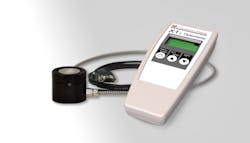UV-C Radiometer for disinfection effectiveness and safety of UV-C LEDs and germicidal lamps
The X1-1-UV-3726 radiometer enables the effectiveness of UV germicidal irradiation (UVGI) to be accurately determined for both low pressure mercury (254nm) germicidal lamps and UV-C LEDs. Additionally, the device has sufficient sensitivity to detect if undesired exposure poses a photobiological safety risk to users.
UVGI is a sterilization method that uses UV-C light to break down microorganisms such as viruses and bacteria by altering their DNA and RNA, rendering them unable to replicate. The germicidal effectiveness of UV-C radiation depends on its dose (µJ / cm2) and wavelength. The dose is determined by measuring the irradiance (µW / cm2) and duration of exposure. The effectiveness of germicidal activity is wavelength dependent with a maximum around 265 nm which makes the potential germicidal efficacy of available UV-C LEDs greater than 254 nm emission Hg lamps.
The X-1-1-UV-3726 radiometer measures UV-C irradiance over a very wide dynamic range to beyond 100 mW / cm² with a resolution of 0.0001 µW / cm². It is calibrated for its spectral responsivity from 250 nm to 300 nm. Wavelength dependent calibration factors given in 5 nm increments are incorporated for measuring UV LEDs with known nominal wavelength. Additionally, a 254 nm calibration is included for Hg lamps as well as a general purpose 260 nm to 290 nm calibration for non-specific UV-C LEDs.
The X1-1-UV-3726 offers sufficient sensitivity to check for safety compliance and the effectiveness of personal protection equipment (PPE) in accordance with the accepted occupational exposure limit to actinic UV (ICNIRP/ACGIH). This requires irradiance levels to be < 0.2 µW/cm2 at 254 nm and < 0.1 µW/cm2 at 270 nm over 8 hour’s exposure.
The handheld meter provides a real time display of irradiance or dose and includes a peak-hold function. The device may also be operated via its USB interface. Each meter is supplied with a traceable calibration certificate from the Gigahertz-Optik laboratory.





